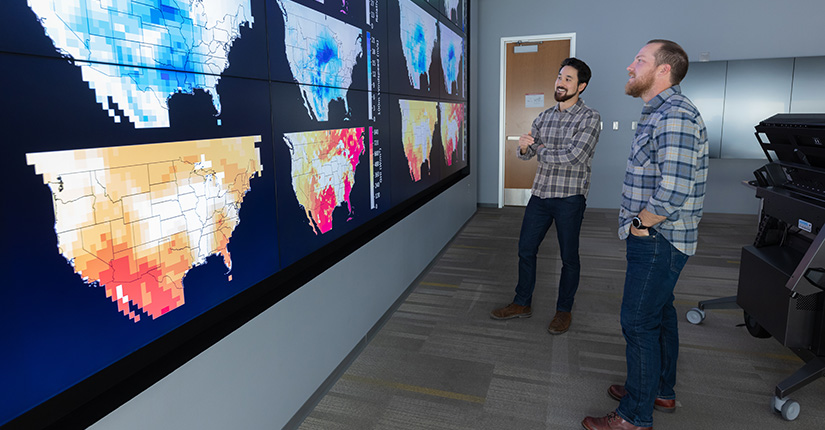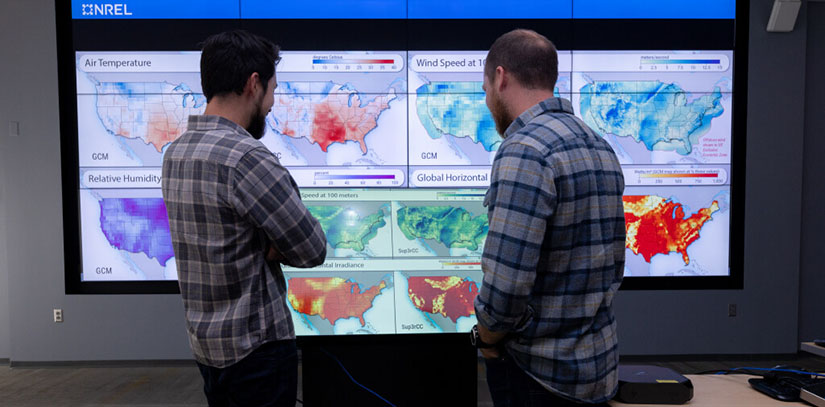NREL Unveils Groundbreaking Generative Machine Learning Model To Simulate Future Energy-Climate Impacts
New Open-Source, Publicly Available Model Rapidly Produces Super-Detailed Future Climate Data To Support Integrated Energy System Planning

Sup3rCC is changing the way we conduct integrated energy system planning. Photo by Joe DelNero, NREL
As countries worldwide transition to more wind and solar generation and electrify energy end uses, societies are becoming more intertwined with weather conditions. Meanwhile, the climate is rapidly changing and making extreme weather events the “new normal.”
Energy system planners and operators need detailed, high-resolution data projected into the future to understand how climate change will impact wind and solar generation, electricity demand, and other weather-dependent energy variables. Available data show that climate change will likely increase energy demand, but there are very few high-resolution resources to quantify these impacts.
“We envision a future where all or nearly all electricity demand is met by renewable energy sources,” said Grant Buster, data scientist at the U.S. Department of Energy's National Renewable Energy Laboratory (NREL). “We need to understand how renewable resources like wind or solar might be impacted by climate change and how those resources will be able to meet our energy needs in the future.”
That is exactly why Grant Buster, Brandon Benton, Andrew Glaws, and Ryan King at NREL developed Super-Resolution for Renewable Energy Resource Data with Climate Change Impacts, or Sup3rCC (fondly pronounced “super-c-c”), which was recently highlighted in a Nature Energy journal article.
Sup3rCC is an open-source model that uses generative machine learning to produce state-of-the-art downscaled future climate data sets that are available to the public at no cost. Downscaled climate data is necessary to understand the impacts of climate change on local wind and solar resources and energy demand. There are a multitude of existing downscaling methods, but they all have trade-offs in resolution, computational costs, and physical constraints in space and time. Sup3rCC represents a new field of generative machine learning methods that can produce physically realistic high-resolution data 40 times faster than traditional dynamical downscaling methods.
“Sup3rCC will change the way we study and plan future energy systems,” said Dan Bilello, director of the Strategic Energy Analysis Center at NREL. “The tool produces foundational climate data that can be plugged into energy system models and provide much-needed insights for decision makers who are responsible for keeping the lights on.”
Overcoming the Energy-Climate Disconnect
Energy system research and climate research have traditionally been siloed for several reasons. The resolution of traditional global climate models is too coarse across both time and space for most energy system models, and enhancing the resolution is computationally expensive. Global climate models also do not always generate or save outputs that are required to model renewable energy generation. Plus, existing publicly available global climate model data sets are not commonly connected to the data pipelines and software used in energy system research.
Because of these persistent challenges, most energy system planners have relied on historical high-resolution wind, solar, and temperature data to model electricity generation and demand. But ignoring future climate conditions can be risky when it comes to planning a reliable energy system, which has been underscored by recent weather-related blackouts in California and Texas.
A growing community of modelers and analysts at NREL are working to overcome the energy-climate disconnect.

Climate and energy are increasingly intertwined. Now there is a tool to study them both. Photo by Billy Roberts, NREL
“Climate science is a complex field with massive amounts of data, huge uncertainties, and not a lot of resources on how the information can or should be applied to other fields of study,” Buster said. “At NREL, we aim to bring the energy and climate modeling communities together to effectively and appropriately use climate information to guide energy system design and operation.”
Sup3rCC was created through a partnership between energy analysts and computational scientists at NREL to better incorporate multi-decadal changes in climate and meteorological variability in energy systems modeling. “This work bridges the gap between energy system and climate research communities to significantly advance the developing field of energy-climate research,” Bilello said.
Leveraging the Power of Artificial Intelligence
Sup3rCC overcomes the computational challenges of traditional dynamical downscaling techniques by leveraging the power of recent advances in a generative machine learning technique called generative adversarial networks (GANS).
“Generative machine learning is the cornerstone technology at the heart of our super-resolution approach,” said Ryan King, computational researcher at NREL and co-developer of Sup3rCC. “It would be impossible for us to produce these analyses without machine learning.”
Sup3rCC learns physical characteristics of nature and the atmosphere by studying NREL’s historical high-resolution data sets, including the National Solar Radiation Database and the Wind Integration National Dataset Toolkit. The model then injects physically realistic small-scale information that it has learned from the data sets into the coarse future outputs from global climate models. As a result, Sup3rCC generates highly detailed temperature, humidity, wind speed, and solar irradiance data based on the latest state-of-the-art future climate projections. Sup3rCC outputs can then be used to study future renewable energy power generation, changes in energy demand, and impacts to power system operations. The initial Sup3rCC data set includes data from 2015 to 2059 for the contiguous United States, and additional data sets will be released in the coming years.
Future wind, solar, and temperature data output from a traditional global climate model (left) versus output from Sup3rCC (right) shows the stark contrast in resolution. Graphic by Grant Buster, NREL
“Our super-resolution work is unique in that we enhance the spatial and temporal resolution simultaneously and inject far more information than ever before,” King said. “Sup3rCC preserves the large-scale trajectories of climate simulations, while endowing them with realistic small-scale features that are crucial for accurate renewable energy resource assessments and load forecasting.”
Sup3rCC increases the spatial resolution of global climate models by 25 times in each horizontal direction and the temporal resolution by 24 times—representing a 15,000-fold increase in the total amount of data. The model can do this process 40 times faster than traditional dynamical downscaling models so energy system planners and operators can get straight to planning at large scales.
It will allow researchers at NREL and beyond to investigate weather events like future heat waves and the interplay between the electrical grid and renewable energy generation.
“Our approach dramatically reduces the computational cost of generating high spatial and temporal resolution data by several orders of magnitude,” King said. “This allows us to consider changes in renewable resources and electrical demand in a multitude of future climate scenarios across multiple decades, which is critical for planning future energy systems.”
Super Data Underpins Bigger, Better Studies
The Sup3rCC data sets join a family of high-resolution data at NREL that have enabled a massive uptick in large-scale renewable energy studies. Outputs from Sup3rCC are compatible with NREL’s Renewable Energy Potential (reV) Model to study wind and solar generation and interoperate with a whole suite of NREL modeling tools. Users can access Sup3rCC data on Amazon Web Services and run reV in the cloud from their own desktop to see how wind and solar generation, capacity, and system cost change under different climate scenarios.
The success of Sup3rCC and many other high-impact, data-driven NREL projects is made possible by the collaboration between two different centers that combined key NREL strengths in analysis and computing.

Innovative collaborations led to the development of Sup3rCC. Photo by Joe DelNero, NREL
NREL’s Strategic Energy Analysis Center is at the forefront of developing data architecture and software solutions needed to power some of the laboratory’s most high-profile, data-intensive studies like the Los Angeles 100% Renewable Energy Study, the Puerto Rico Grid Resilience and Transitions to 100% Renewable Energy Study, and the National Transmission Planning Study. The advanced data solutions are making energy data more accessible, usable, and actionable for NREL researchers and engineers and beyond.
These advanced data solutions would also not be possible without NREL's Computational Science Center, which uses computational methods to develop groundbreaking, cross-disciplinary data acquisition and analysis. For example, in the LA100 study, a multidisciplinary team of dozens of NREL experts used NREL's supercomputer to run more than 100 million simulations at ultrahigh spatial and temporal resolution to evaluate a range of future scenarios for how LADWP's power system could evolve to a 100% renewable future. Meaningful collaborations like this between analysis and computational science are advancing NREL research in energy efficiency, sustainable transportation, energy system optimization, and more.
“By working together with other centers and groups across the laboratory, we can help elevate the overall data capabilities at NREL,” Bilello said. “Through collaboration we are building a framework to prepare us to take on new, innovative, data-focused research challenges.”
Learn More About Sup3rCC
To learn more about Sup3rCC, access the Sup3rCC open-source code and data sets and read a Nature Energy article about the model and data release.
Learn more about NREL's energy analysis research, or contact Grant Buster at [email protected].
Last Updated May 28, 2025
